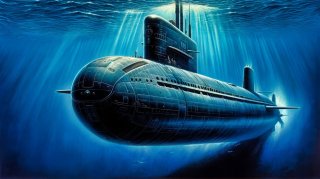Forget the Skies, the U.S. Military Is Looking for UFOs Below the Waves
No matter how much is learned about UAP in the atmosphere, a complete understanding of anomalous phenomena will remain hidden absent dedicated research in our largely unknown oceans.
Throughout the early stages of the Cold War, there was a significant focus on unidentified flying objects (UFOs)—more recently known as an unidentified anomalous phenomenon (UAP). Most UFOs/UAPs have been identified as known objects or atmospheric phenomena, yet, a small number remained unexplained.
That fact has led to wild conspiracy theories, but UAPs are still seen as a very serious source of concern as these objects could pose a clear and present danger to the security of the United States. That fact was highlighted in a Department of Defense (DoD) report released last month, which found that while there is no evidence of “extraterrestrial technology,” official records and public reporting are filled with evidence of unknown craft that exhibit what appears to be extraordinary technology.
However, there has been a focus not just on what has been seen in the skies, but also on what may be lurking below the waves. Rear admiral and oceanographer Tim Gallaudet recently authored a white paper for the Sol Foundation think tank and called for greater attention on unidentified submersible objects (USOs). He suggested that while past research and attention have been on aerial occurrences, instances of UAP at sea, whether under the surface or traveling “transmedium”—between the atmosphere and the ocean—are also occurring.
“We have less research on transmedium UAP and USOs than is ideal, yet what data there is points to a few conclusions. First, these underwater anomalies jeopardize US maritime security, which is already weakened by our relative ignorance about the global ocean. Second, their presence in the oceans at the same time presents an unprecedented opportunity for maritime science. Third, to meet the security and scientific challenges, transmedium UAP and USOs should be elevated to national ocean research priorities,” wrote Gallaudet.
He further suggested that the security implications of UAP and USO and the scientific ramifications are nothing short of world-changing.
Mysteries of the Deep
For eons, sailors have claimed to have spotted the seemingly unexplainable at sea, and that included mythical creatures like the Kraken and mermaids, as well as phantom ships such as the infamous “Flying Dutchman.” The mysterious creatures were attributed to misidentified marine life, while the Flying Dutchman was actually fabricated by the British as propaganda in retaliation against the Dutch East India Company.
Yet, there remain countless mysteries of the deep—which isn’t all that surprising as 95 percent of the ocean remains unexplored. There is no doubt that some undersea life has yet to be seen.
As the U.S. Naval Institute noted in 2022, “to date, there has been no documented damage to a plane caused by a UFO,” yet, the report identified multiple incidents where vessels have had all too close encounters with aquatic life that in another time might have been described as “sea monsters.”
That included the 1978 incident involving the Knox-class destroyer escort USS Stein (DE-1065) and an unknown species of giant squid. The “NOFOUL” rubber coating of the vessel’s AN/SQS-26 sonar dome was damaged by multiple cuts. While that might not seem all that unusual, the cuts contained remnants of sharp, curved claws found on the rims suction cups of some squid tentacles—and these were far larger than any squid that had ever been encountered!
What Is Under the Sea?
The number of unexplained incidents at sea is as great as those seen in the sky.
“The underwater and transmedium UAP reported in these sources are as diverse as their aerial counterparts, including luminous orbs, silver and gray discs, and triangular and cigar-shaped objects with various lighting configurations. Large lighted craft are often seen under the sea surface without ever emerging,” explained Gallaudet.
He added that subsequent research has shown that many such phenomena often have a down-to-earth explanation—bioluminescent organisms excited by near-surface turbulence—and that this serves to “remind us that prosaic explanations for phenomena should always be considered to avoid jumping to conclusions about alien craft.”
Yet, Gallaudet added that there is still much we can’t easily explain, and worse, perhaps not enough is being said or done about it.
“The fact that unidentified objects with unexplainable characteristics are entering US water space and the DOD is not raising a giant red flag is another sign that the government is not sharing all it knows about all-domain anomalous phenomena,” wrote Gallaudet.
He further warned that the focus shouldn’t be just what is seen in the heavens above, which is finally getting the attention it may deserve.
“Not so in Neptune’s realm,” Gallaudet concluded in his paper. “No matter how much is learned about UAP in the atmosphere, a complete understanding of anomalous phenomena will remain hidden absent dedicated research in our largely unknown oceans. Without gazing into the abyss, one will never know if the abyss does indeed return the gaze.”
Author Experience and Expertise: Peter Suciu
Peter Suciu is a Michigan-based writer. He has contributed to more than four dozen magazines, newspapers, and websites with over 3,200 published pieces over a twenty-year career in journalism. He regularly writes about military hardware, firearms history, cybersecurity, politics, and international affairs. Peter is also a Contributing Writer for Forbes and Clearance Jobs. You can follow him on Twitter: @PeterSuciu. You can email the author: [email protected].


